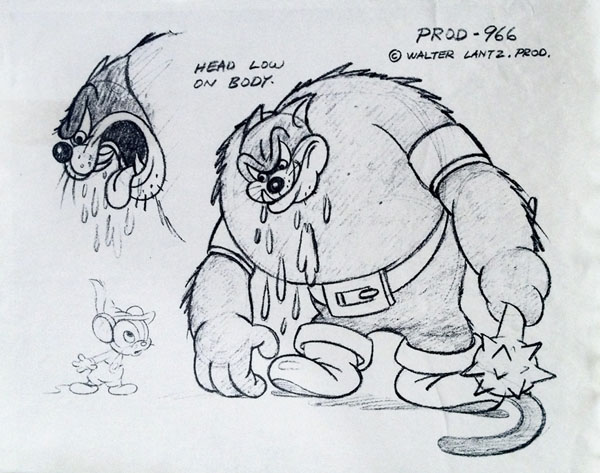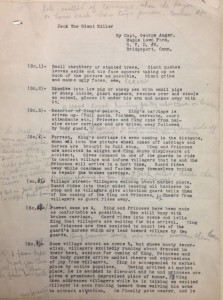
Within the UCLA archives, there resides an intriguing artifact: a script submitted to Walter Lantz by Captain George Auger of Maple Lawn Farm in Bridgeport, Connecticut. For a while after I had first seen it, I dismissed it as a keepsake that Lantz had politely but not seriously considered from a decorated military commander. Perhaps this was someone he had known from his years producing training films for the Navy. Had Captain Auger now fancied himself a screenwriter who could call in a favor with the one Hollywood producer he knew?
The story synopsis was undated, but the manner of its typed format struck me as similar to materials I had seen in the studio archive from the 1930s or some time before the Second World War. There was nothing remarkable about the writing, a derivative story about Jack and a Giant. However, there were pencil notes among the typed sentences, leading me to think it had gotten some real scrutiny from a Lantz story artist. Also, I knew that Lantz had twice made a Jack and the Beanstalk-themed cartoon during the period just before and after the war.I delved into finding out more about this “Captain” from Connecticut, whom I envisioned as a U.S. Navy man. However, my searches returned the identity of someone who could not possibly fit the profile, yet had been an international celebrity and was given the honorific of Captain by none less than Queen Victoria of England, for his service as a policeman and guard of the royal palace. Because Auger stood about seven and a half feet tall, he must have cut quite an impression when he walked ahead of the Queen as part of her London police escort. He was her personal security giant.
The story goes that the Barnum & Bailey Circus was on its tour of England when Auger attended and had the unique experience of looking down at an American circus giant. Not to be upstaged, Barnum & Bailey negotiated a contract with him and soon he was one of its traveling performers. Auger was born in Wales, so he was given a promotional stage name, The Cardiff Giant, which was ironic because the original ‘Cardiff Giant’ was a fossilized artifact which P.T. Barnum had once haggled to buy, but when his efforts failed he then sued the owner and unleashed a legal spectacle that led to the attraction’s public denouement as a hoax.

Captain George Auger was no hoax, but his new handling by circus promoters — The Greatest Show on Earth – with its audacious brand of American hucksterism that dared to trump the claims of all its rivals—led to some revaluations of his height. He was now judged anywhere from eight feet to eight and a half feet tall, by various accounts. Barnum & Bailey took him to America in 1903, where his celebrity grew faster than the additional inches he was purported to have stood head-to-toe.
To his credit, Auger eventually left the circus and wrote a play he would star in titled “Jack the Giant Killer.” It was a vehicle to pursue his interest in acting, with a show that toured the Orpheum vaudeville circuit starting in 1906 and amazingly continued playing through the First World War. In all its performances across North America over a ten year stretch, Auger was never the hero but instead the looming giant who is felled by Jack.

By this point, there was far too much coincidence to possibly think that anyone but THIS George Auger was responsible for the cartoon script that Walter Lantz held in his studio files. The animated film synopsis shared the same title as the vaudeville play and additional research turned up the clinching fact: after years of touring in America, George Auger had taken a permanent residence in Fairfield County with his wife Bertha. This is the same county in Connecticut where Bridgeport is located, justifying the address on the Lantz manuscript as that of the Welshman whom many considered the Tallest Man in the World.
Everything was lining up perfectly except one daunting fact: the date of his death, tragically premature. How possibly could he have gotten the script to Lantz? He was a man of the Victorian Age who died in 1922. A story run by the United Press syndicate only confirmed this, that the Captain’s death was mourned by Ringling, his loyal and appropriately named bulldog:
“Ringling, Auger’s favorite pet, has refused to leave the room where his master’s coffin was placed, since the circus performer’s death Thursday night. The dog trooped with Auger from the Pacific to the Atlantic and was to have gone with his master to California next week, where the giant had contracted to appear in the movies.”
Only forty years old, he was readying for his next act in Hollywood, and his outreach to filmmakers had begun in earnest, including signing to appear in a Harold Lloyd comedy. His sheer size made him a stronger draw as an actor for live-action films, but possibly Lantz was intrigued at making his own animated “Jack the Giant Killer” as a tribute or homage.

A model sheet from “The Magic Beans” (1939)
Exhibit A and B are both cartoons that were made long after Auger’s death: The Magic Beans (1939) and Woody the Giant Killer (1947). The link may seem tenuous, but the connection to the Captain’s script is not out of the question, especially if Lantz had ever made his acquaintance all those years before. That remains a question I’ll continue in my next post, as we turn over more clues in our search.
Yet, one thing stands out as an irony or at least a stereotype that even Auger did not try to diminish in his capacity as the writer of his own play. He never challenged the conventional expectation that a giant needed to be subdued or killed, the ritualized conquest of man over beast. In “Jack the Giant Killer,” a conflict ensues when the giant captures a princess and puts her in a dungeon. In reality, George Auger was by all accounts such an imposing but well-liked palace guard that the royalty he protected gave him an honorary rank and nickname. As Mickey might have said, Gosh Save the Queen.

(The Captain Auger script resides in the archive of UCLA Special Collections. Courtesy of University of California, Los Angeles. The photograph of actors from the Orpheum production of “Jack the Giant Killer” appears courtesy of Bob Osborne, whose great uncle was William George Auger.)



 Tom Klein is a Professor and the Chair of the Animation program at Loyola Marymount University, in Los Angeles. He has been published internationally and has been profiled in The New York Times for his work as a scholar of the Walter Lantz studio. He has worked at Vivendi-Universal Games and Universal Cartoon Studios. Follow him @VizLogic
Tom Klein is a Professor and the Chair of the Animation program at Loyola Marymount University, in Los Angeles. He has been published internationally and has been profiled in The New York Times for his work as a scholar of the Walter Lantz studio. He has worked at Vivendi-Universal Games and Universal Cartoon Studios. Follow him @VizLogic



















































The Harold Lloyd film was “Why Worry?”, released in 1923 and available on video. John Aasen inherited the part intended for Auger. It’s a still-funny slapstick feature about a hypochondriac (Lloyd) who stumbles into a banana republic revolution. Lloyd befriends a gigantic cellmate in the local jail (Aasen), who helps him defeat the American “renegade” in charge. Aasen also died young, of pneumonia at age 48.
At 6’9″ Ted Cassidy wasn’t quite in Auger’s league, but he did make it into the cartoon biz as a busy voice actor. Warner Archive just released “The New Adventures of Huckleberry Finn”, where he played Injun Joe and voiced his numerous animated doppelgängers. Continuing the sad trend, he was only 46 when he died (complications from surgery).
As an amateur show business historian for decades, I am fascinated to read your column today, Mr. Klein–I knew absolutely NOTHING about this! Thank you very much!
And thank you, too, “Benson,” for your additional historical observations on the subject.
Wotta story! Can’t wait for the next installment.
Great article!One question-“The Magic Beans” looks like a Baby Face Mouse cartoon,yet I have no recollection of it being listed as such.Any info on that?
Seems it was the first of two “Nertsery Rhyme” cartoons. The “Jack” character is a young mouse called Beany, but clearly Baby-Face Mouse.